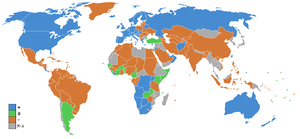
Net migration rate
Encyclopedia

Example
On January 1, 2000 country A has a population of 1,000,000 inhabitants. From that date to January 1, 2001, 200,000 people immigrated to A, and 100,000 people left the country. At the same time, there were 100,000 babies born, and nobody died. Therefore, the population of A On January 1, 2001 is 1,200,000.We consider that on July 1, 2000 (the middle of our time term) there were 1,100,000 inhabitants.
And since 100,000 left and 200,000 came, the migration difference is +100,000.

But this value is per inhabitant, and we want a per 1,000 persons value:

This number gives us a comparable idea of the impact of migration on the country's population.
See also
- DemographyDemographyDemography is the statistical study of human population. It can be a very general science that can be applied to any kind of dynamic human population, that is, one that changes over time or space...
- Human migrationHuman migrationHuman migration is physical movement by humans from one area to another, sometimes over long distances or in large groups. Historically this movement was nomadic, often causing significant conflict with the indigenous population and their displacement or cultural assimilation. Only a few nomadic...
- List of countries by net migration rate
- Population dynamicsPopulation dynamicsPopulation dynamics is the branch of life sciences that studies short-term and long-term changes in the size and age composition of populations, and the biological and environmental processes influencing those changes...
- Migration Efficiency

